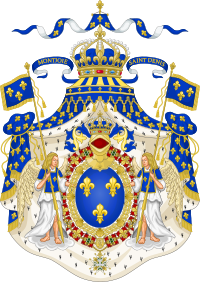Philippe I, Duke of Orléans
| Philippe | |
|---|---|
| Duke of Orléans | |
 |
|
| Philippe wearing the Order of the Holy Spirit, France's highest order of chivalry unknown painter |
|
| Spouse | Princess Henrietta of England Elizabeth Charlotte of the Palatinate |
| Issue | |
| Marie Louise, Queen of Spain Anne Marie, Queen of Sardinia Philippe, Duke of Orléans Élisabeth Charlotte, Duchess of Lorraine |
|
| Full name | |
| Philippe de France[1] | |
| House | House of Orléans House of Bourbon |
| Father | Louis XIII of France |
| Mother | Anne of Austria |
| Born | 21 September 1640 Château de Saint Germain en Laye, Saint Germain en Laye, France |
| Died | 9 June 1701 (aged 60) Château de Saint Cloud, Saint Cloud, France |
| Burial | 21 June 1701 Royal Basilica of Saint Denis, Saint Denis, France |
| Religion | Roman Catholic |
Philippe de France (21 September 1640 – 9 June 1701) was the youngest son of Louis XIII of France and his queen consort Anne of Austria. His older brother was the famous Louis XIV, le roi soleil. Styled Duke of Anjou from birth, Philippe became Duke of Orléans upon the death of his uncle Gaston, Duke of Orléans, in 1660. During the reign of his brother, he was known simply as Monsieur. An open homosexual, he married twice: first to his first cousin, the attractive and popular Henrietta of England, Minette, sister of Charles II of England. During their marriage, Philippe met and began a relationship with the Chevalier de Lorraine. The Chevalier was the great love of Philippe's life, their long relationship beginning in 1668[2]. The Chevalier was accused of poisoning Minette. Married again in 1671 to Elizabeth Charlotte of the Palatinate, Liselotte, his second marriage was far happier and produced two surviving children, both of whom would produce an abundance of grandchildren that would make Philippe a mutual ancestor of most modern-day Roman Catholic royals [3] and giving him the nickname of "grandfather of Europe"[4]. The founder of the House of Orléans, his only surviving son being Philippe d'Orléans, Regent of France for the infant Louis XV. The House of Orléans ruled France from 1830 till 1848 in the July Monarchy which was headed by Louis Philippe I, King of the French[5]. His other legacies include his decisive victory at the Battle of Cassel in 1677. Through careful personal administration, Philippe greatly augmented his personal fortune and thus the fortune of the House of Orléans.
Contents |
Early years
Birth and ancestry
Philippe was born at the Château de Saint Germain en Laye in the town of Saint Germain en Laye, France. As the son of a ruling King, the infant Philippe held the prestigious rank of Fils de France (son of France)[1]. As such, he ranked immediately behind his older brother Louis, Dauphin of France. From birth, he was second in line to the throne of France and was entitled to the style of Royal Highness[1].
Born in the presence of his father, the Princess of Condé,[6] and Duchess of Vendôme, an hour after his birth he was baptised in a private ceremony by Dominique Séguier, Bishop of Meaux[7] and was given the name Philippe. Louis XIII had wanted to give the infant the title of Count of Artois in honour of a recent French victory in Arras within the county of Artois. However, Louis stuck with tradition and gave him the title of Duke of Anjou, title for a second born son since the time of Saint Louis, Philippe's ancestor[7]. After baptism, Philippe was put in the care of Françoise de Souvré, marquise de Lansac who also looked after his older brother.
Philippe was a product of noteworthy European ruling houses. His paternal grandparents were Henry IV and Marie de' Medici; his maternal grandparents were Habsburgs — Philip III of Spain and Margaret of Austria. Through them he was descended from Charles V, Holy Roman Emperor and Frederick Barbarossa.

Tracing his ancestry to the tenth generation, genealogist C. Carretier calculated his ancestry to be approximately 28% French, 26% Spanish, 11% Austro-German and 10% Portuguese, the rest being Italian, Slavic, English, Savoyard and Lorrainer.[8].
His varied ancestry caused his older cousin, the Duchess of Montpensier, to dub him the "prettiest child in the world"[9]. His mother's friend and confidant, Madame de Motteville, later said of Philippe that, early on in childhood, he displayed a "lively intelligence".
Le Petit Monsieur
At the death of his father in May 1643, his older brother succeeded him as Louis XIV of France. Queen Anne revoked the late king's will leaving power shared between Anne and Gaston, Duke of Orléans. Power thus rested with Anne and she was in full control of the country as well as of her children, something she had been vying for since their birth. As the younger brother of the king, he was addressed as le Petit Monsieur as his uncle Gaston was still alive. Gaston, a favorite of Philippe, was thus known as le Grand Monsieur. It was not till 1660 at the death of Gaston that Philippe would be known simply as Monsieur or as the Duke of Orléans[10].
Queen Anne was noted to call Philippe such nicknames as "my little girl" and encouraged him to dress in feminine clothing even as a young man – a trait he would have all his life[11]. Later on in his life, a contemporary called him the "silliest woman who ever lived", a reference to his overt sexuality[12]. Even as a young man, Philippe would dress up and attend balls and parties in female attire or dressed as a shepherdess. [13]His inclination toward homosexuality was not discouraged, with the hope of reducing any threat he may have posed to his older brother. Reportedly, Cardinal Mazarin even arranged for the de-flowering of Philippe at the hands of his own nephew[14][15].
Aged 7, in autumn 1647, Philippe caught smallpox but recovered and convalesced at the Palais Royal. A year later, he was taken from the care of woman and on, 11 May 1648, he carried out his first official ceremony when he was baptised publicly at the Palais Royal[16]. His godparents were his uncle Gaston d'Orléans and aunt Queen Henrietta Maria of England. Later on, he was placed in the care of François de La Mothe Le Vayer and the Abbé de Choisy[17]. He was also educated by the maréchal du Plessis-Praslin. His tutors were chosen by Mazarin who was created the Superintendent of the princes education by their mother. His education turned to Latin amongst various other languagues, history, literature, mathematics as well as dancing[18]. Despite having a household of his own, his behavior was closely watched by his mother and Mazarin, who made sure Philippe had no meaningful financial freedom from the crown[19]
When Philippe was 8, the Fronde began, a civil war in France in two main parts called the Fronde Parlementaire (1648–1649) and the Fronde des nobles (1650–1653). During the latter, Philippe, his mother and brother had to flee Paris on the night of 9 February 1651[20] for the safety of Saint Germaine[21] from the attack by the French nobility on the Palais Royal aimed at Mazarin.
Peace having returned in 1652, the decision was made for Philippe to now move his household to the Palais des Tuileries, previous residence of Mademoiselle and situated next to the Palais Royal[22]. The next year at the coronation of his brother at the Cathedral of Reims on 7 June 1654 it was the thirteen year old Philippe who acted as dean placing the crown of France on his brother's head. All his life, Philippe would be a noted lover of etiquette and all things ceremonial ensuring that all details of which were adhered to[23].
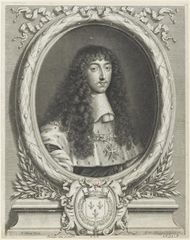
Philippe's sexuality came into question in 1658 when court gossip said that Mazarin's own nephew the Philippe Jules Mancini, the Duke of Nevers, had in fact been the "first to [have] coruppted" Philippe in what was called the vice italien – contemporary slang for homosexuality[25][26].
In late June 1658, Louis became gravely ill. Presumed to have Typhoid, Louis was almost pronounced dead when, in mid-July, he began to recover. The illness made Philippe, heir presumptive to the throne, the center of attention. For fear of infection, Philippe could not see his brother. During the crisis, Queen Anne became closer to her younger son, showing him more affection[27]. Louis having recovered, Mazarin opened negotiations with Queen Anne's native Spain as well as the court of Savoy.
Having survived his brother's illness, Philippe was once again left to his own devices. In 1658, Philippe made his most significant purchase, the Château de Saint Cloud, a building about 10 kilometres west of Paris. On 8 October 1658, the then proprietor Barthélemy Hervart organised a sumptuous feast at Saint Cloud in honour of the royal family. Some two weeks later, on 25 October, Philippe bought the château and its grounds for 240,000 Livres[19]. He immediately began to organise improvements to what was then a small villa[19].
Around the same time, Philippe met Armand de Gramont the Count of Guiche who was a notorious playboy and noted gallant. Philippe was infatuated with the famously arrogant Guiche who was exiled from the court by Mazarin. At the same time, rumours at court stated that Philippe in fact had a mistress[28] and had showed an interest in the Duchess of Mercoeur, Mazarin's own niece and mother of Louis Joseph, Duke of Vendôme, later a successful soldier and notable homosexual of the era[29]. Another lover of Philippe at the time was Antoine Coiffier, the marquis d'Effiat. The latter had entered Philippe's life as the capitaine des chasses and stayed in his household till Philippe's death[30].
Philippe's love scandal having died down the court paid attention to the marriage of the king. Mazarin had opened correspondence with Queen Anne's brother, relations with whom were fragile due to the Franco-Spanish War. The resulting Treaty of the Pyrenees[31] ended the war and was cemented with the marriage of Louis XIV and Philip IV's daughter the Maria Teresa of Austria. They were married on 9 June 1660[31] at Saint-Jean-de-Luz. With Louis married, Queen Anne began to turn her attention to the marriage of Philippe.
Duke of Orléans
As his uncle Gaston died in February 1660, the Duchy of Orléans reverted back to the crown as he had no surviving male issue[32], as his only son, the Duke of Valois, had died at the age of 2. As the duchy was one of the most highly regarded appanages of the Ancien régime, it was technically his birth right as the brother of the king. As such, at the death of Gaston, Philippe himself took on the new style of Duke of Orléans despite not having officially received the title. Louis XIV granted Philippe the title and on 10 May 1661[33] along with the subsidiary titles of duke of Valois and duke of Chartres with the acceptance of the Parlement de Paris[33]. He was granted the duchies of Valois, Chartres and lordship of Montargis[34].
Marriage with Minette
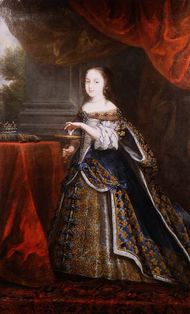
Philippe had previously been encouraged to court his older cousin Anne Marie Louise d'Orléans, eldest daughter of Gaston and his first wife Marie de Bourbon. Known as Mademoiselle she had an immense private fortune and had previously rejected suitors such as Charles II of England[36]. Born in 1627, she was the sole heiress of her mother who died in childbirth. Mademoiselle declined the union complaining that Philippe always stayed near his mother as if he was "like a child"[37]. Mademoiselle instead remained unmarried[38].
Instead Philippe would marry another first cousin in the form of Princess Henrietta of England, youngest child of the executed Charles I of England and his wife Queen Henrietta Maria. The latter was a member of the French court and lived at the Palais Royal from 1652 till her daughters marriage[39].
Henrietta born in Exeter was given the name Anne in honour of Queen Anne and had lived in France since the age of 2 having been smuggled out of England by the Countess of Morton[40]. Henrietta lived with her mother Queen Henrietta Maria at the Palais Royal and at the Louvre. She visited England late in 1660 to visit her sister the Princess of Orange[41] who later caught smallpox and died. The French court officially asked for Henrietta's hand on 22 November 1660 while in England[42].
The couple signed their marriage contract at the Palais Royal on 30 March 1661[43] the ceremony occurring the next day in the same building in front of select members of the court[44]. The dowry promised was a huge 840,000 Livres[45]. Known as Henriette d'Angleterre in France, and Minette to her intimates, she was known as officially as Madame and was ever popular with the court and had many admirers. Court gossip later said that the king was the father of Minette's first child. Minette's very open flirting is said to have caused a jealous Philippe to retaliate by beginning to openly flaunt his sexuality in an age which was not as accepting[46].
Minette and her "flirting" with the king started early in the summer of 1661 while the newly-weds were staying at the Fontainebleau for the summer. Philippe even complained to his mother about the intimacy Louis XIV and Minette displayed causing Queen Anne to reprimand both son and daughter in law[47]. Relations were further strained when Minette allegedly seduced Philippe's old lover Guiche[48].
The couple moved from the Tuileries in early 1662 to the Palais Royal. Later in March of the same year, Philippe became a father, Minette giving birth to a daughter who was later named Marie Louise. The disappointment of Minette was great and upon finding out that the child was female, she remarked that she should "throw her into the river!"[49] which greatly offended Queen Anne who adored her first granddaughter[50]. In 1665, Guiche left the court with Philippe reporting to Queen Anne that Minette had had private interviews with the dashing nobleman; Guiche left on the pretext of offending the king and was thus exiled[51].
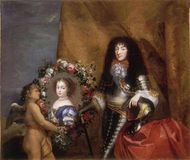
Minette's and Philippe's daughter was baptised Marie Louise on 21 May 1662[52]. On the same day Philippe took part in the famous Carrousel du Louvre where he dressed extravagantly as the King of Persia with the king as the King of the Romans and all ladies of the court in attendance[53]. Despite the annual celebrations at court, the ducal couple would not have another child till 1664 when Minette gave birth at Fontainebleau to a desired son who was given the title Duke of Valois[54]. Philippe wrote to his brother in law Charles II of England "that your sister was this morning safely delivered of a fine boy. The child seems to be in excellent health"[55]. The son however died in 1666 of convulsions having been baptised Philippe Charles d'Orléans hours before death[56]. The loss of the little Duke of Valois affected Minette greatly. However Philippe, according to contemporaries, was anxious to maintain the allowance which his son had received from the king.[57] This death only augmented the court's grief as they were still in mourning for the death of Queen Anne of Austria, of breast cancer in January[58].
In the year 1668 Philippe met the future love of his life. Philippe de Lorraine known as the Chevalier de Lorraine was a member of the House of Lorraine and had the rank of Foreign Prince at the French court, his cousin being the ruling Duke of Lorraine.
In 1667, Philippe took part in the War of Devolution in order to appear like his grandfather Henry IV[59] on the battlefield; "Follow me to the camp and you will see how well I can fight"[60]. Minette stayed at Saint Cloud as she was again in the state of pregnancy. While on the field, Philippe took an active part within the trenches at Tournai and Douay and had distinguished himself by his valour and coolness under fire[61]. However, Philippe, later bored of the field became more interested in the decoration of his tent. Hearing of Minette being ill due to a miscarriage, he returned to Saint Cloud where she was recovering from an ordeal which almost costing her her life[62]. However at her recovery, Philippe returned to the siege of Lille and further distinguished himself[63].
In January 1670, his wife prevailed upon the King to imprison the Chevalier, first near Lyon, then in the Mediterranean island-fortress of the Château d'If, and finally he was banished to Rome having offended the king and offending Minette by boasting he could get Philippe to divorce her[64]. In retaliation to the Chevalier's treatment, Philippe went to his estate at Villers-Cotterêtt dragging Minette with him[65]. But by February Philippe's protests and pleas persuaded the King to restore him to his brother's entourage.
The couple had their last child in August 1669. The child, a daughter and another disappointment was baptised Anne Marie at the private chapel of the Palais Royal on 8 April 1670 by the Duke of Orléans' first chaplain, the Bishop of Vabres. Present were King king, Queen Marie Thérèse, Monseigneur le Dauphin and Mademoiselle the latter pair acting as godparents. When Queen Henriette Marie, died, Princess Anne of England came to live with Philippe and Minette leaving at Minette's death.
Minette is best known for her part in the Secret Treaty of Dover which was an offensive and defensive treaty between England and France signed at Dover on 1 June[66] 1670. It required France to assist England in her aim to rejoin the Roman Catholic Church and England to assist France in her war of conquest against the Dutch Republic. The Third Anglo-Dutch War was a direct consequence of this treaty.
Having returned to France at the end of June 1670, Minette had to endure Philippe's blatant spite[67] for her part in the Chevalier's exile and her secret mission to Dover. Despite tense relations, Minette went to Saint Cloud on 24 June when she started to complain of pains in her side[68]. Relaxing at Saint Cloud on 30 June she collapsed on the terrace at the palace. Taken inside, she was undressed and started to exclaim she had been poisoned[69]. Subsequently Minette died between the hours of two and three in the morning of 30 June 1670 at the age of 26[70].
At Minette's funeral, Bishop Bossuet pronounced the famous oration stating "Madame is dying! Madame is dead!"[71] emphasizing the level shock he death caused for one so popular. Subsequently the Chevalier de Lorraine and the marquis d'Effiat[72] was accused of poisoning Minette however an autopsy was preformed it was declared that Minette died of peritonitis caused by a perforated ulcer[73].
| Painting commissioned by Philippe for Saint Cloud, Jean Nocret, 1670 |
|---|
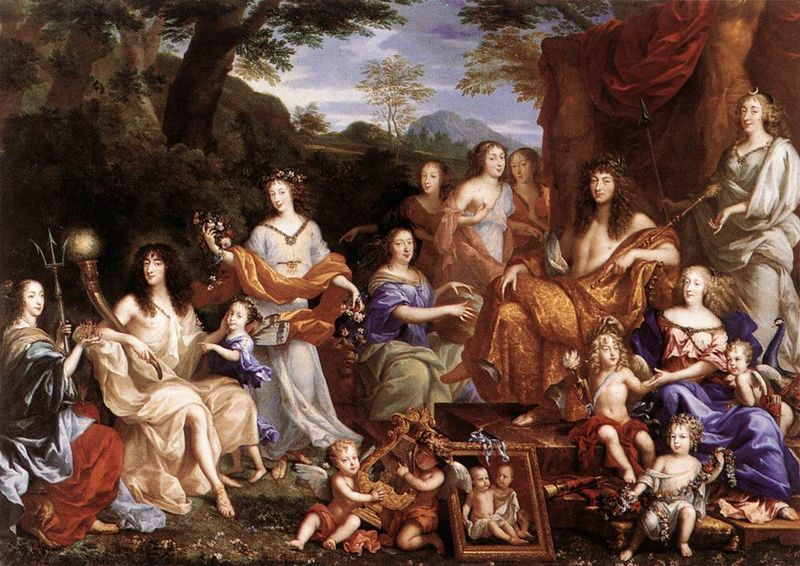
A mural commissioned c.1670 by the Philippe; (L-R) Queen Henrietta Maria of England; Philippe; his daughter Marie Louise; Minette; Queen Anne (d. 1666); Philippe's cousins, daughters of Gaston d'Orléans; Louis XIV; le Grand Dauphin; Queen Marie Therèse with her daughter Madame Royale; the Duke of Anjou; stood to the right is Mademoiselle. The picture frame with the two children are two deceased daughters of Louis and Marie Therèse.
|
"A vacant place"
Minette was mourned greatly at court but little by her husband due to the strained relationship. Louis XIV himself looked for a wife for Philippe who was eager to have a male heir to continue the Orléans line[74]. Attention again turned to Mademoiselle; Louis asked her if she wanted to fill "the vacant place"[75]. However, she politely declined the offer[76].
Other unmarried princesses of Europe included Anna Maria Luisa de' Medici, daughter of the Grand Duke of Tuscany (as well as niece of Mademoiselle who was her namesake), Maria Anna Josepha of Austria as well as the various daughters of the Elector Palatine.
Disregarding many, Louis XIV looked further afield in order to find his brother a bride. Louis XIV's choice fell upon the Protestant Elizabeth Charlotte of the Palatinate. Known as Liselotte within her family, she was the only daughter of the Elector Palatine and his estranged wife Charlotte of Hesse-Kassel. Liselotte came recommended by Anna Gonzaga who was a close friend of Philippe and was the aunt by marriage of Liselotte. Liselotte was first cousin of the Duchess of Enghien, daughter in law of the Grand Condé.
Liselotte's father, Charles I Louis, an impoverished German prince of the Holy Roman Empire had married Charlotte of Hesse-Kassel in 1650, and the couple had three children, the middle of whom, Elizabeth Charlotte, was born in 1652[77]. Liselotte grew up lived with her aunt Sophia of Hanover due to her parents bad relations; throughout her life Liselotte would remain in contact with Sophie writing some 50,000 letters detailing the court which are today used widely by historians[78]. Liselotte had previously rejected the Duke of Courland (son of Jacob Kettler) as well as the Margrave of Baden-Durlach[79].
Marriage with Liselotte
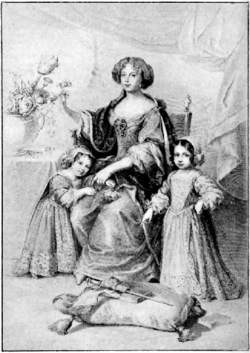
Philippe married a newly converted Roman Catholic[72] on 16 November 1671[80]. Liselotte was not attractive like Minette had been. When Philippe first saw her, he is said to have remarked "how will I ever be able to sleep with her?"[81]. Madame de Sévigné noted how popular the new Madame was with the court. Liselotte also became known for her brusque candor, upright character and lack of vanity. Her letters record how willingly she gave up sharing Philippe's bed at his request after their children's births and how unwillingly she quietly endured the presence of his mignons in their household.
The couple were very happy in the first years of their marriage. The Chevalier was in Italy but would return in spring 1672. Pregnant later that year, Liselotte gave birth to a son in June 1673 who was named Alexandre Louis and given the title Duke of Valois. Alexandre Louis would however die in 1676[82]. A second son would follow in 1674 and then a daughter in 1676 after which they would mutually agree to sleep in separate beds[83]. Despite having no more children, Liselotte was praised as being a good and natural mother[84].
Liselotte acted as a mother to Philippe's children by Minette and maintained correspondence with the two their last days. Marie Louise however would always be Philippe's favourite child.
In 1680, the Chevalier de Lorraine was again caught in a sex scandal this time with the Count of Vermandois, Louis XIV's own son by Louise de La Vallière. Vermandois died in exile but the Chevalier stayed[85]. The Prince of Conti was also involved[86].
The Battle of Cassel
Having already had a pleasing military career during the War of Devolution in 1667, Philippe was eager to return to the field while at the height of his glory at court and within his own family. In 1676 and 1677 he took part in sieges of Flanders and was promoted to the rank of Lieutenant general being second in command to Louis XIV himself. However in 1674 and 1678 he had gone to the field as a volunteer.
The most dazzling victory Philippe carried out was on 11 April 1677 at the Battle of Cassel against William III of Orange[87], the son his own first cousin, the dead Princess of Orange. William II, Prince of Orange decided to relieve the besieged towns; from Ypres he marched at the head of an army of 32,000 men through Poperinge and Oxelaëre at the Cassel Valley. Philippe, who learned his way, went to meet them the Dutch troops at Penebeek between Noordpeene and Zuytpeene. Louis XIV sent him from Cambrai with some 25,000 foot soldiers and 9000 cavalry under the command of the maréchal de Luxembourg. By nightfall there were 66,000 soldiers for battle.
| "The people of Paris went wild with joy. They really love Monsieur. But at court they'd wished he'd lost the battle for the kings sake..." |
| Extract from the memoirs of Primi Visconti [88] |
The Dutch stormed French positions without first exploring the site. The result was that the maréchal de Luxembourg was able to attack with a cavalry to surprise the Dutch, creating a Constitutional Battalion was practically destroyed three other battalions forcing the William and his Dutch troops to flee. In total, both sides were 4200 deaths and 7000 injuries. Philippe was dubbed the gallant soldier much to his brothers dislike[89] who was presumanbly jealous of his brothers ever growing popularity at court as well as on the field. Philippe's famous victory at Cassel was the be the termination of his military career and thus he was thrown back into a life of his favourites, parties and dissipation[87].
In honour of his achievement, Philippe set up a Barnabite college in Paris in honour of the battle[90]. Regarding the battle, Philippe was noted as having showed "much valor"[91] as noted by Saint-Simon.
Cultural expansion and property
The success of Cassel caused problems for Philippe. Having always been unable to attend meetings of state unless unimportant[92] and further exiled to the background, Philippe turned his attention to his fortune, properties and ever growing family.
From 1677 till 1690s, Philippe concentrated his spirit on the expansion of his estates, personal fortune, art collection as well as the revamping of his residences the Palais Royal and the Château de Saint Cloud, the latter was his favourite residence[93] and was was the home of an evergrowing and "stormy" court[72]. As such, Philippe became an important patron of Jean Nocret and Pierre Mignard both of which were employed to elaborate the décor at both Saint Cloud and at the Palais Royal. The left of the château wing was decorated by Jean Nocret in 1660, and the 45-metre Galerie d'Apollon[94], which occupied the whole of the right wing, was decorated with myths of Apollo by Pierre Mignard finished in 1680. As early as 1660, Philippe also ordered Antoine Le Pautre[87] to begin extensions at Saint Cloud later becoming his contrôleur général of the properties of Philippe. Le Pautre was responsible for the famous cascade, constructed in 1664–1665, within the gardens of Saint Cloud which survive today.
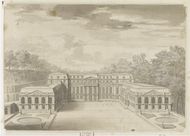
Following Le Pautre's death in 1679, the work was continued by his executive assistant Jean Girard, a master mason rather than a full-fledged architect with added input from Thomas Gobert. Later on Philippe sought Mansart to design a grand stair in the left wing in the manner of the Ambassadors' Staircase at Versailles. The corps de logis of the château was designed by Jean Girard who had previously worked with Le Pautre between the years 1677 and 1681. Within the building was a room named the salle de Cassel[95] in honour of his military accomplishment. He further increased the size of the estate in 1678[96].
The gardens were replanned by André Le Nôtre evidence of which can still be seen today. The basin and the lowermost canal were added by Mansart in 1698. Saint Cloud remained with the Orléans till 1785[97] when Philippe's great grandson Louis Philippe d'Orléans sold it to Marie Antoinette[98] for the sum of 6 million Livres; interestingly, Marie Antoinette was Philippe's great grand daughter.
Minor improvements the Palais Royal had began in 1661[99] at the time of Philippe's marriage to Minette[100] but the property was part of the crown and had not been used properly for years. He was limited in what he could do to the building until it was given to him in 1692[101], when Philippe again turned to Jules Hardouin Mansart to sort out whereas interior décor was entrusted to Antoine Coypel whose father Noël Coypel had previously worked at the Palais Royal[102].
In 1695, Philippe bought a small island in the Seine which was directly opposite the château. Once purchased, Philippe promptly renamed it the Île de Monsieur. At the time of Philippe's death in 1701 the estate of Saint Cloud numbered some 1200 acres.
Saint Cloud was the home of Philippe's household as well as a royal residence. The château was where his children Anne Marie (1669), Philippe (1674) and Élisabeth Charlotte (1676) were born. The château played host to Louis XIV at the death of Queen Marie Thérèse in 1683 before he moved to Fontainebleau[103].
Philippe not only enjoyed architecture and the social calender of the court, but was a keen on music and was often noted for his exceptional dancing abilities. As noted he was a keen supporters of architects along with painters. He was a patron of the infamous Molière as well as a range of musicians in the era such as Anglebert, Dumont, Arlaud and Marie Aubry many of which would stay part of his sons household after 1701. Lully, another homosexual, was later a protégé of Philippe after he left Mademoiselle's household when she returned to court after her exile. Philippe's small art collection created the basis for the Orleans Collection, one of the most important art collections which has ever been created[104].
With the permission of the parlement, Philippe set about the maintenance of his estates as well as their profitability. From 1679[105], Philippe had the right to build the Canal d'Orléans, a large canal which connected the Loire River at Orléans to a junction with the Canal du Loing and the Canal de Briare in the village of Buges near Montargis[105]. The construction of this canal was an engineering feat being the largest built in France since Philippe's grandfather Henri IV built the Canal de Briare in 1604. The canal was used to transport goods from Orléans to Paris and was a great success in its time[105] and is still used widely today.
Philippe's careful investment and management of his various estates made him a wealthy man in his own right, a fortune augmented at the death of his cousin Mademoiselle in 1693. Philippe is acknowledged as being not only the biological founder of the House of Orléans but as financial founder[106] of a family whose monetary value would rival that of the main line of the house of Bourbon[107].
Marriage of Marie Louise
Philippe's favourite daughter was his eldest, Marie Louise, who was popular with the court and had inherited her mother's beauty and charm.[108].
Philippe was immensely proud that his daughter was to be the Queen of Spain as wife of Charles II of Spain, and made sure that all matters of etiquette were observed[109]. Despite Philippe's pleasure at the match, the marriage remained sterile, and Marie Louise died at the age of 26, like her mother[110]. When Philippe was informed he was devastated[111] becoming as sad as "he could ever be about anything"[112].
Marriage of Philippe
Louis XIV organised the marriage's of all of Philippe's children. Philippe's only surviving son Philippe d'Orléans, known as the Duke of Chartres in his father's lifetime was married to Françoise Marie de Bourbon, Légitimée de France in 1692. Françoise Marie was the legitimised daughter of Louis XIV and his ravishing mistress Madame de Montespan. Born in 1677[113], she was known as Mademoiselle de Blois prior to marriage and having been legitimised in 1681[114]. As she was born an illegitimate, she was regarded as a poor match regardless of who her father was.
As few foreign princesses were available for Chartres (who was a Grandson of France) who was a highly prestigious candidate for any foreign princess. Upon hearing of the marriage, a proud Mademoiselle de Blois exclaimed "Je ne me soucie pas qu'il m'aime, je me soucie qu'il m'épouse"[115] [I don't care if he loves me, just as long as he marries me].
Philippe and Liselotte were not convinced despite the promise of a huge dowry of 2 million Livres as well as the sole ownership of the Palais Royal. However, when Louis XIV promised various court appointments for the Chevalier de Lorraine as well as the marquis d'Effiat, he was won round under the influence of the Count of Armagnac, brother of the Chevalier[116]. Liselotte was a different matter; Liselotte's bitter dislike of people who were illegitimate was well known at court and on hearing that Chartres had accepted the match, slapped him round the face in front og the whole court[117]!
With no choice, Liselotte concented to the marriage, Chartres and Mademoiselle de Blois being married on 18 February 1692 at Versailles. The service was conducted by the Cardinal de Bouillon and guests included the exiled king of England and his wife. At the newlyweds' bedding ceremony later that evening, the exiled Queen of England had the honour of giving the new Duchess of Chartres her night shirt. Madame de Montespan, had not been invited to the wedding of her daughter. The huge dowry was not to be paid till the Nine Years' War was over[118].
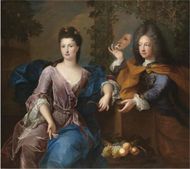
The union was one of discord. Not long after their marriage, Philippe openly ridiculed his wife's bad temper by nicknaming her Madame Lucifer[120]. Liselotte said that during the early years of the Chartres marriage, Françoise Marie was as "drunk as drunk" three to four times a week[121]. Despite a loveless marriage some seven surviving children were produced four of which would have further progeny.
With the Palais Royal now his property, Philippe himself decided to redecorate the interior having previously left it as it was part of the crown and preferring to lavish his resources on Saint Cloud. The Palais Royal Louis XIV subsequently gave 100,000 livres to the Chevalier de Lorraine.
This marriage ensured the ducal line would survive, however Philippe would not see the birth of his sons son Louis d'Orléans who was born in 1703 at Versailles. Louis was the grand father of Philippe Égalité born in 1747 at Saint Cloud.
Later years, death and burial
At the death of Mademoiselle in April 1693, she made Philippe her main heir[107]. From her death, Philippe became the Duke of Montpensier, Châtellerault, Saint-Fargeau and Beaupréau. He also became the Prince of Joinville as well as count of Dourdan, Mortain, Bar-sur-Seine and Viscount of Auge and of Domfront.
In later life, Philippe maintained his lavish lifestyle. His son enjoyed an active and distinguished military career having already served in the Battle of Steenkerque in 1692 as well as the Siege of Namur, much to his father's pride [122]. As he had with Philippe, Louis XIV reamined careful to limit the power of Chartres.
In 1696 Philippe's grand daughter Maria Adelaide, eldest child of Anne Marie came to the French court for her marriage to the Duke of Burgundy who was third in line to the throne[123]. The two were married in 1697 and were the parents of Louis XV[124].
| "I won Monsieur over during the last three years of his life. We even used to laugh together about his weaknesses. [...] He had confidence in me and always took my side, but before that I used to suffer dreadfully. I was just beginning to be happy when the almighty took poor Monsieur from me" |
| Liselotte writing in 1716 to the Princess of Wales regarding their mutual affection in the later years of their marriage[125] |
In 1701, Chartres was not given a position on the front for the War of the Spanish Succession which had began that year as most European refused to recognise Philip V as king[126]. Chartres not having an appointment caused bitter anger both father and son the latter of which had been under close scrutiny from Louis XIV having paraded his mistress Mademoiselle de Séry in view of his wife[127]. On 8 June 1701 Louis XIV and Philippe met at the Marly so the two could dine together. Upon entering Louis XIV attacked Philippe about Chartres' conduct with Mademoiselle de Séry[128]. Philippe reprimanded Louis for his treatment of his mistresses during his marriage to Queen Marie Thérèse to a shocked Louis[129] adding that Chartres had still not received the favours promised to Chartres for having married Françoise Marie. The announcement of dinner halted the argument and the brothers sat down to dine[130]
Philippe angrily returned to Saint Cloud early the same evening to dine with his son. Philippe collapsed onto his son having had a Stroke[131] at noon 9 June 1701 at the age of sixty[130]. Louis XIV, upon hearing his only sibling had died said "I can not believe I will never see my brother again"[132]. The Duchess of Burgundy, his grand daughter was hard hit stating that she "had loved Monsieur very much"[133]. Philippe's heart was taken to the Val-de-Grâce convent on 14 June[130]. His body was taken to the 21 June to the Royal Basilica of Saint Denis where it remained till the French Revolution when the basilica was dessicrated and all graves destroyed[134].
Liselotte, worried she would be put in a convent (which was part of her wedding contract[135]) now as a defunct widow of the kings brother was assured she could remain at court as long as she wished[132]. Liselotte burnt all the letters[136] of Philippe's lovers through the years lest they fall into "the wrong hands"[137] declaring perfume from the letters made her nauseous[132]. Louis XIV assured the new duke that the past was forgotten and that from now on, he was to look on Louis XIV as his father[133]. The court was devastated and his old friend Madame de Montespan was also greatly affected, the two having been very close[138].
The widowed Liselotte continued to write to her daughter, step-daughter, and her the Duchess of Modena[139]. Liselotte herself died at Saint Cloud in December 1722[140]. She too was buried at Saint Denis. The Chevalier de Lorraine died in 1703 impoverished.
Portrayals in media
Philippe has been portrayed in various modern media:
- Charles II: The Power and The Passion (2003 mini-series) played by Cyrille Thouvenin[141].;
- Vatel (2000 film) played by Murray Lachlan Young[142].;
- Le Roi Soleil (2005 musical) played by Christophe Maé;
- The Man in the Iron Mask (1998 film) played by Leonardo di Caprio[143].;
- Liselotte von der Pfalz (1966 film) played by Harald Leipnitz[144];
- Liselotte von der Pfalz (1935 film) played by Hans Stüwe[145].
Issue
| House of Orléans |
|---|
.svg.png) |
| See descendants |
|
|
|
|
|
|
|
|
|
|
|
|
First marriage
Philippe married Princess Henrietta of England on 31 March 1661, at the Palais Royal. The couple had the following children:
- Marie Louise d'Orléans, Granddaughter of France (26 March 1662 – 12 February 1689) married Charles II of Spain, no issue;
- Philippe Charles d'Orléans, Duke of Valois, Grandson of France (16 July 1664 – 8 December 1666) died in infancy;
- Stillborn daughter (9 July 1665);
- Anne Marie d'Orléans, Granddaughter of France (27 August 1669 – 26 August 1728) married Victor Amadeus II, Duke of Savoy (future king of Sardinia) and had issue;
Second marriage
Philippe married Elizabeth Charlotte of the Palatinate 16 November 1671 at Châlons. The couple had the following children:
- Alexandre Louis d'Orléans, Duke of Valois, Grandson of France (2 June 1673 – 16 March 1676) died in infancy;
- Philippe Charles d'Orléans, Duke of Chartres (1674–1701), Duke of Orléans (1701–1723), Grandson of France (2 August 1674 – 2 December 1723) married Françoise Marie de Bourbon, Légitimée de France and had issue;
- Élisabeth Charlotte d'Orléans, Granddaughter of France (13 September 1676 – 24 December 1744) married Léopold de Lorraine, Duke of Lorraine and had issue.
Ancestors
| Ancestors of Philippe de France | ||||||||||||||||||||||||||||||||||||||||||||||||||||||||||||||||||||||||||||||||||||||||||||||||||||||||||||||||||||||||||||||||||||||||||||||||||||||||||||||||||||||||||||||||||||||||||||||||||||||||||||||||||||||||||||||||||||||||||||||||||||||||||||||||||||||||||||||||||||||||||||||||||||||||||||||||||||||||||||||||||||||||||||||||||||||||||||||||||||||||||||||||||||||||||||||||||||||||||||||||||||||||||||||||||||||||||||||||||||||||||||||||||||||||||||||||||||||||||||||||||||||||||||||||||||||||||||||||||||||||||||||||||||||||||||||||||
|---|---|---|---|---|---|---|---|---|---|---|---|---|---|---|---|---|---|---|---|---|---|---|---|---|---|---|---|---|---|---|---|---|---|---|---|---|---|---|---|---|---|---|---|---|---|---|---|---|---|---|---|---|---|---|---|---|---|---|---|---|---|---|---|---|---|---|---|---|---|---|---|---|---|---|---|---|---|---|---|---|---|---|---|---|---|---|---|---|---|---|---|---|---|---|---|---|---|---|---|---|---|---|---|---|---|---|---|---|---|---|---|---|---|---|---|---|---|---|---|---|---|---|---|---|---|---|---|---|---|---|---|---|---|---|---|---|---|---|---|---|---|---|---|---|---|---|---|---|---|---|---|---|---|---|---|---|---|---|---|---|---|---|---|---|---|---|---|---|---|---|---|---|---|---|---|---|---|---|---|---|---|---|---|---|---|---|---|---|---|---|---|---|---|---|---|---|---|---|---|---|---|---|---|---|---|---|---|---|---|---|---|---|---|---|---|---|---|---|---|---|---|---|---|---|---|---|---|---|---|---|---|---|---|---|---|---|---|---|---|---|---|---|---|---|---|---|---|---|---|---|---|---|---|---|---|---|---|---|---|---|---|---|---|---|---|---|---|---|---|---|---|---|---|---|---|---|---|---|---|---|---|---|---|---|---|---|---|---|---|---|---|---|---|---|---|---|---|---|---|---|---|---|---|---|---|---|---|---|---|---|---|---|---|---|---|---|---|---|---|---|---|---|---|---|---|---|---|---|---|---|---|---|---|---|---|---|---|---|---|---|---|---|---|---|---|---|---|---|---|---|---|---|---|---|---|---|---|---|---|---|---|---|---|---|---|---|---|---|---|---|---|---|---|---|---|---|---|---|---|---|---|---|---|---|---|---|---|---|---|---|---|---|---|---|---|---|---|---|---|---|---|---|---|---|---|---|---|---|---|---|---|---|---|---|---|---|---|---|---|---|---|---|---|---|---|---|---|---|---|---|---|---|---|---|---|---|---|---|---|---|---|---|---|---|---|---|---|---|---|---|---|---|---|---|---|---|---|---|---|---|---|---|---|---|---|---|---|---|---|---|---|---|---|---|---|---|---|---|---|---|---|---|---|---|---|---|---|---|---|---|---|---|---|---|---|---|---|---|---|---|---|---|---|---|---|---|---|---|---|---|---|---|---|---|---|---|---|---|---|---|---|---|---|---|---|---|---|---|---|---|---|---|---|---|---|---|---|---|---|---|---|---|---|---|---|---|
|
||||||||||||||||||||||||||||||||||||||||||||||||||||||||||||||||||||||||||||||||||||||||||||||||||||||||||||||||||||||||||||||||||||||||||||||||||||||||||||||||||||||||||||||||||||||||||||||||||||||||||||||||||||||||||||||||||||||||||||||||||||||||||||||||||||||||||||||||||||||||||||||||||||||||||||||||||||||||||||||||||||||||||||||||||||||||||||||||||||||||||||||||||||||||||||||||||||||||||||||||||||||||||||||||||||||||||||||||||||||||||||||||||||||||||||||||||||||||||||||||||||||||||||||||||||||||||||||||||||||||||||||||||||||||||||||||||
Titles, styles, honours and arms
Titles and Styles
.svg.png)
.svg.png)
- 21 September 1640 – 14 May 1643 His Royal Highness the Duke of Anjou
- 14 May 1643 – 2 February 1660 His Royal Highness Monsieur, Duke of Anjou
- 2 February 1660 – 9 June 1701 His Royal Highness Monsieur, Duke of Orléans
Honours
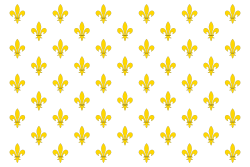 8 June 1654: Knight of the Order of the Holy Spirit
8 June 1654: Knight of the Order of the Holy Spirit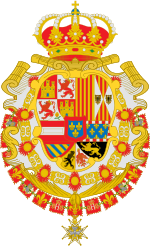 1701: Knight of the Order of the Golden Fleece
1701: Knight of the Order of the Golden Fleece 1701: Knight of the Order of Saint Michael
1701: Knight of the Order of Saint Michael
Arms
Azure, three fleur-de-lis or and a label argent bezanty
[In heraldic blazon, Azure is blue, Or is gold, and Argent is silver]
References
- ↑ 1.0 1.1 1.2 François Velde (July 4, 2005). "The French Royal Family: Titles and Customs". heraldica.org. http://www.heraldica.org/topics/france/frroyal.htm. Retrieved 2010-07-09.
- ↑ Crompton, p 342
- ↑ Hilton, p 294
- ↑ Mitford, p 55
- ↑ Hilton, 293
- ↑ Barker, p 3
- ↑ 7.0 7.1 Barker, p 4
- ↑ Carretier, p 132
- ↑ Barker, p 14
- ↑ Barker, p 15
- ↑ Crompton, p 342
- ↑ Crompton, p 341
- ↑ Crompton, p 341
- ↑ Erlanger, Philippe, Louis XIV, translated from the French by Stephen Cox, Praeger Publishers, New York, 1970, p. 75 (footnote).
- ↑ Dufresne, Claude, Les Orléans, CRITERION, Paris, 1991, p. 33 (French).
- ↑ Barker, p 17
- ↑ Barker, p 16
- ↑ Barker, p 21
- ↑ 19.0 19.1 19.2 Barker, p 54
- ↑ Vatout, p 51
- ↑ Vatout, p 56
- ↑ Barker, p 41
- ↑ Barker, p44
- ↑ Mitford, p55
- ↑ Erlanger, p 75 (footnote)
- ↑ Mitford, p 51
- ↑ Barker, p 52
- ↑ Mitford, p 54
- ↑ Barker, p 60
- ↑ Gerard, p 116
- ↑ 31.0 31.1 Fraser, p 70
- ↑ Barker, p 70
- ↑ 33.0 33.1 François Velde (July 4, 2005). "Armory of Old Regime (pre-1789) French Peerage". heraldica.org. http://www.heraldica.org/topics/france/peerage2.htm. Retrieved 2010-07-09.
- ↑ Anthony, p 195
- ↑ Fraser, p 76
- ↑ Sackville-West, p 106
- ↑ Sackville-West, p 206
- ↑ Sackville-West, p 224
- ↑ Vatout, p 57
- ↑ Fraser, p 32
- ↑ Cartwright, p 70
- ↑ Cartwright, p 69
- ↑ Barker, p 76
- ↑ Cartwright, p 84
- ↑ Barker, p 125
- ↑ Barker, p 75
- ↑ Barker, p 78
- ↑ Barker, p 61
- ↑ Cartwright, p 115
- ↑ Cartwright, p 114
- ↑ Cartwright, p 116
- ↑ Cartwright, p 118
- ↑ Cartwright, p 118
- ↑ Cartwright, p 163
- ↑ Cartwright, p 164
- ↑ Cartwright, p 240
- ↑ Cartwright, p 241
- ↑ Mitford, p 25
- ↑ Cartwright, p 243
- ↑ Cartwright, p 243
- ↑ Cartwright, p 243
- ↑ Cartwright, p 244
- ↑ Cartwright, p 245
- ↑ Cartwright, p 307
- ↑ Cartwright, p 312
- ↑ Cartwright, p 278
- ↑ Barker, p 114
- ↑ Fraser, p 154
- ↑ Barker, p 114
- ↑ Fraser, p 155
- ↑ Barker, p 115
- ↑ 72.0 72.1 72.2 Mitford, p 56
- ↑ Robinson, James, The History of Gastric Surgery, chapter 20, p 239
- ↑ Fraser, p 157
- ↑ Sackville-West, p 266
- ↑ Barker, p 123
- ↑ Fraser, p 161
- ↑ Fraser, p 163
- ↑ Cooke Taylor, p 136
- ↑ Barker, p 128
- ↑ Barker, p 129
- ↑ Barker, p 156
- ↑ Fraser, p 166
- ↑ Barker, p 139
- ↑ Hilton, p 160
- ↑ Crompton, p 340
- ↑ 87.0 87.1 87.2 Pevitt, p 17
- ↑ Buckley, p 180
- ↑ Barker, p 166
- ↑ Williams, p 17
- ↑ Crompton, p 341
- ↑ Mitford, p 100
- ↑ Pevitt, p 11
- ↑ Pevitt, p 18
- ↑ Barker, p 171
- ↑ Saint-Albin, p 13
- ↑ Saint-Albin, p 7
- ↑ Saint-Albin, p 9
- ↑ Vatout, p 58
- ↑ Vatout, p 59
- ↑ Vatout, p 63
- ↑ Barker, p 168
- ↑ Fraser, p 246
- ↑ Watson, Peter; Wisdom and Strength, the Biography of a Renaissance Masterpiece, Hutchinson, 1990, Watson, 202
- ↑ 105.0 105.1 105.2 Barker, p 186
- ↑ Barker, p 198
- ↑ 107.0 107.1 Fraser, p 279
- ↑ Fraser, p 201
- ↑ Barker, p 211
- ↑ Cartwright, p 396
- ↑ Barker, p 212
- ↑ Fraser, p 278
- ↑ Hilton, p 167
- ↑ Hilton, p 222
- ↑ ib. Dufresne, p 78
- ↑ Cooke Taylor, p 152
- ↑ Fraser, p 282
- ↑ Pevitt, p 41
- ↑ Fraser, p 227
- ↑ Dufresne, p 74
- ↑ Fraser, p 232
- ↑ Pevitt, p 55
- ↑ Fraser, p 298
- ↑ Pevitt, p 111
- ↑ Crompton, p 345
- ↑ Lynn, p 16
- ↑ Pevitt, p 56
- ↑ Barker, p 220
- ↑ Fraser, p 319
- ↑ 130.0 130.1 130.2 Barker, p 231
- ↑ Pevitt, p 57
- ↑ 132.0 132.1 132.2 Fraser, p 320
- ↑ 133.0 133.1 Mitford, p 204
- ↑ Barker, p 232
- ↑ Cooke Taylor, p 161
- ↑ Gerard, p 111
- ↑ Buckley, p 338
- ↑ Mitford, p 206
- ↑ Gerard, p 112
- ↑ Cooke Taylor, p 170
- ↑ ""Charles II: The Power & the Passion" (2003 mini series) Internet Movie Database". IMDb.com. http://www.imdb.com/title/tt0364800/. Retrieved 2010-07-9.
- ↑ "Vatel (2000 film) Internet Movie Database". IMDb.com. http://www.imdb.com/title/tt0190861/. Retrieved 2010-07-9.
- ↑ "The Man in the Iron Mask (1998 film)". IMDb.com. http://www.imdb.com/title/tt0120744/. Retrieved 2010-07-9.
- ↑ "Liselotte von der Pfalz (1966 film)". IMDb.com. http://www.imdb.com/title/tt0060631/. Retrieved 2010-07-9.
- ↑ "Liselotte von der Pfalz (1935 film)". IMDb.com. http://www.imdb.com/title/tt0026631/. Retrieved 2010-07-9.
Bibliography
- Anthony, Louisa : Footsteps to history, being an epitome of the histories of England and France, from the fifth to the nineteenth century, 1852
- Barker, Nancy Nichols : Brother to the Sun King; Philippe, Duke of Orléans, John Hopkis University Press, Baltimore/London, 1989, ISBN 0801861640
- Buckley, Veronica : Madame de Maintenon; The Secret wife of Louis XIV, Bloomsbury, London, 2008 ISBN 9780747480980
- Carretier, Christian : Les cinq cent douze quartiers de Louis XIV", Angers-Paris, 1980
- Cartwright, Julia : Madame: A life of Henrietta, daughter of Charles I and Duchess of Orléans, Seeley and Co.Ltd, London, 1900
- Cooke Taylor, William : Memoirs of the house of Orleans: Volume 1, R. Bentley, 1849
- Crompton, Louis :Homosexuality & Civilization, Harvard University Press, 2006, ISBN 0674022335
- Dufresne, Claud : Les Orléans, Criterion, Paris, 1991
- Erlanger, Philippe : Louis XIV, translated from the French by Stephen Cox, Praeger Publishers, New York, 1970
- Fraser, Antonia : Love and Louis XIV; The Women in the Life of the Sun King, Anchor Books, London, 2006, ISBN 9780753822937
- Gerard, Kent & Hekman, Gert : The Pursuit of sodomy: male homosexuality in Renaissance and Enlightenment Europe, Routledge, 1989, ISBN 9780866564915
- Hilton, Lisa. : Athénaïs The Real Queen of France, Little Brown, London, 2002 ISBN 0 316 85878 1
- Lynn, John : The Wars of Louis XIV, 1667–1714, New York, Longman, 1999 ISBN 0582056292
- Mitford, Nancy : The Sun King, Penguin Publishing, London, 1966, ISBN 0140239677
- Pevitt, Christine : The Man Who Would Be King: The Life of Philippe d'Orléans, Regent of France, Phoenix, London, 1997, ISBN 9780753804599
- Sackville-West, Vita : Daughter of France: The life of Anne Marie Louise d'Orléans, duchesse de Montpensier 1627–1693, Micheal Joseph, London, 1959,
- Saint-Albin, Philippe de :Palais de Saint-Cloud, résidence impériale, Paris, 1864
- Vatout, Jean : Histoire du Palais-royal, Paris, 1830
- Williams, H. Noel : A Rose of Savoy, Marie Adelaide of Savoy, duchesse de Bourgogne, Mother of Louis XV, Charles Scribners Sons, New York, 1909
|
Philippe I, Duke of Orléans
Cadet branch of the House of Capet
Born: 21 September 1640 Died: 9 June 1701 |
||
| French nobility | ||
|---|---|---|
| New title | Duke of Orléans 10 May 1661 – 9 June 1701 |
Succeeded by Philippe II |
| Preceded by Anne Marie Louise |
Duke of Montpensier 5 April 1693 – 9 June 1701 |
|
| Prince of Joinville 5 April 1693 – 9 June 1701 |
||
|
||||||||||||||||
|
||||||||||
|
||||||||||||||||||||||||||||||||||||
|
||||||||||||||||||||||||||||||||||||||||||||||||||||||||||||||||||||||||||||||||||||||||||||||||||||||||||||||||||||||||||||||||||||||||
.svg.png)
